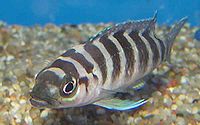- Neolamprologus
-
Neolamprologus 
Neolamprologus brichardi from Lake Tanganyika. Scientific classification Kingdom: Animalia Phylum: Chordata Superclass: Osteichthyes Class: Actinopterygii Subclass: Neopterygii Infraclass: Teleostei Superorder: Acanthopterygii Order: Perciformes Family: Cichlidae Tribe: Lamprologini Genus: Neolamprologus
Colombe & Allgayer, 1985Species About 50, but see text.
Neolamprologus is a genus of cichlid fishes endemic to eastern Africa with all but one species[1] occurring in Lake Tanganyika. It is the largest genus of cichlids in Lake Tanganyika and also the largest genus in the tribe Lamprologini, which includes Altolamprologus, Chalinochromis, Julidochromis, Lamprologus, Lepidiolamprologus, Telmatochromis and Variabilichromis. The latter is a monotypic genus doubtfully distinct from Neolamprologus.
It is already known for some time that according to mtDNA sequence analysis, this genus is very probably polyphyletic. It is likely that it will be revised eventually; if Variabilichromis is split off, at least some of the more ancient lineages currently polaced in Neolamprologus are probably worthy of separation also. However, the morphological similarity and numerous undescribed species do not make analyses easier, and as with many cichlids, recent speciation and abundant hybridization seriously confound molecular studies to the point where single-gene studies or those using only mtDNA or nDNA are essentially worthless for resolving Lamprologini phylogeny.[2]
While lineages are clearly different in their morphology, habits and ecology, gene flow between genera and species is common enough due to extremely low postzygotic isolation. Males of Neolamprologus apparently have always readily and successfully mated with females of other Lamprologini they found ready to spawn: mtDNA lineages similar to other Lamprologini genera are widely encountered in species placed in Neolamprologus. And not only do such hybrids seem to be fertile at least to a limited extent in many cases, new species often appear to originate from such interbreeding.[3]
Species
About 1-2 new species are described every year[4]. Neolamprologus fasciatus is sometimes placed in Altolamprologus[5], and this seems well warranted. Some other species are occasionally moved to Lepidiolamprologus; this placement may also be correct but requires verification.[3]
- Neolamprologus bifasciatus Büscher, 1993
- Neolamprologus boulengeri (sometimes in Lepidiolamprologus)
- Neolamprologus brevis
- Neolamprologus brichardi (often included in N. pulcher)
- Neolamprologus buescheri
- Neolamprologus cancellatus Aibara, Takahashi & Nakaya, 2005
- Neolamprologus caudopunctatus
- Neolamprologus chitamwebwai Verburg & Bills, 2007
- Neolamprologus christyi
- Neolamprologus crassus
- Neolamprologus cylindricus Staeck & Seegers, 1986
- Neolamprologus devosi Schelly, Stiassny & Seegers, 2003
- Neolamprologus falcicula
- Neolamprologus furcifer
- Neolamprologus gracilis
- Neolamprologus hecqui (sometimes in Lepidiolamprologus)
- Neolamprologus helianthus Büscher, 1997
- Neolamprologus leleupi
- Neolamprologus leloupi
- Neolamprologus longicaudatus Nakaya & Gashagaza, 1995
- Neolamprologus longior
- Neolamprologus marunguensis Büscher, 1989
- Neolamprologus meeli (sometimes in Lepidiolamprologus)
- Neolamprologus modestus
- Neolamprologus mondabu
- Neolamprologus multifasciatus
- Neolamprologus mustax
- Neolamprologus niger
- Neolamprologus nigriventris Büscher, 1992
- Neolamprologus obscurus
- Neolamprologus olivaceous
- Neolamprologus pectoralis Büscher, 1991
- Neolamprologus petricola
- Neolamprologus pleuromaculatus
- Neolamprologus prochilus
- Neolamprologus pulcher
- Neolamprologus pulcher 'Daffodil'[6]
- Neolamprologus savoryi
- Neolamprologus schreyeni
- Neolamprologus sexfasciatus
- Neolamprologus similis
- Neolamprologus splendens
- Neolamprologus tetracanthus
- Neolamprologus toae
- Neolamprologus tretocephalus
- Neolamprologus variostigma Büscher, 1995 (sometimes in Lepidiolamprologus)
- Neolamprologus ventralis Büscher, 1995
- Neolamprologus walteri Verburg & Bills, 2007
- Neolamprologus wauthioni
- edit] Footnotes
References
- Day, Julia J.; Santini, Simona & Garcia-Moreno, Jaime (2007): Phylogenetic relationships of the Lake Tanganyika cichlid tribe Lamprologini: The story from mitochondrial DNA. Mol. Phylogenet. Evol. 45(2): 629–642. doi:10.1016/j.ympev.2007.02.025 (HTML abstract)
- FishBase (2006): Neolamprologus species. Version of 2006-MAR-14. Retrieved 2008-AUG-25.
- Konings, A. (1998): Tanganyikan cichlids in their natural habitat. Cichlid Press.
- Llambi, Lenny (2003): Neolamprologus pulcher "Daffodil II". Fincinnati 2003. PDF fulltext
- Sturmbauer, C.; Verheyen. E.; Meyer, A. (1994): Mitochondrial phylogeny of the Lamprologini, the major substrate spawning lineage of cichild fishes from Lake Tanganyika in eastern Africa. Mol. Biol. Evol. 11(4): 691-703. PDF fulltext
Categories:- Lamprologini
- Fauna of Tanzania
Wikimedia Foundation. 2010.
Look at other dictionaries:
Neolamprologus — cylindricus Systematik Ordnung: Barschartige (Perciformes) Unterordnung … Deutsch Wikipedia
Neolamprologus — Neolamprologus … Wikipédia en Français
Neolamprologus — ? Neolamprologus Изящный лампрологус (Neolamprologus cylindricus) Научная классификация … Википедия
Neolamprologus — Neolamprologus Neo … Wikipedia Español
Neolamprologus — Neolamprologus … Wikipédia en Français
Neolamprologus brichardi — Systematik Unterordnung: Lippfischartige (Labroidei) Familie … Deutsch Wikipedia
Neolamprologus Furcifer — Neolamprologus furcifer … Wikipédia en Français
Neolamprologus furcifer — Neolamprologus furcifer … Wikipédia en Français
Neolamprologus leleupi — Ne pas confondre avec Neolamprologus leloupi. Lamprologue jaune … Wikipédia en Français
Neolamprologus cylindricus — Neolamprologus cylindricus … Wikipédia en Français


